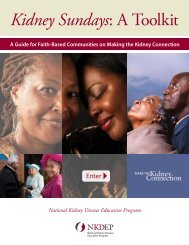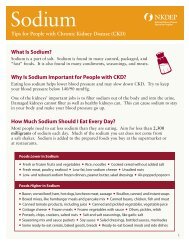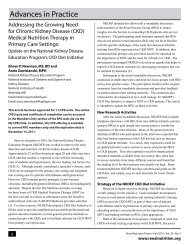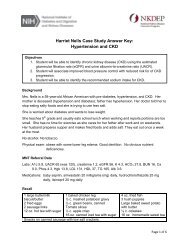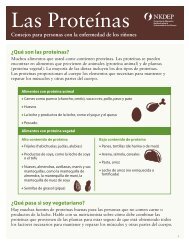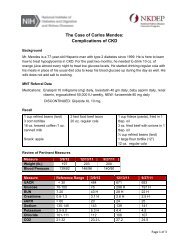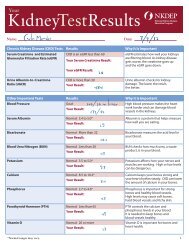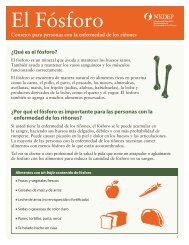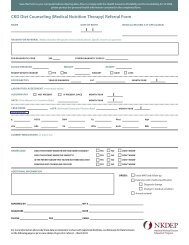The Case of Millie Jones: Dyslipidemia and CKD Answer Key
The Case of Millie Jones: Dyslipidemia and CKD Answer Key
The Case of Millie Jones: Dyslipidemia and CKD Answer Key
You also want an ePaper? Increase the reach of your titles
YUMPU automatically turns print PDFs into web optimized ePapers that Google loves.
<strong>Millie</strong> <strong>Jones</strong> <strong>Case</strong> Study <strong>Answer</strong> <strong>Key</strong>:<br />
<strong>Dyslipidemia</strong> <strong>and</strong> <strong>CKD</strong><br />
Objectives<br />
1. Student will associate normal urine albumin-to-creatinine ratios (UACR) with slower<br />
progression <strong>of</strong> chronic kidney disease (<strong>CKD</strong>).<br />
2. Student will identify diet strategies that may reduce lipids in <strong>CKD</strong>.<br />
3. Student will identify total 25(OH)D as the marker for vitamin D status in <strong>CKD</strong>.<br />
4. Student will identify hemoglobin as marker <strong>of</strong> anemia <strong>and</strong> transferrin saturation <strong>and</strong><br />
ferritin as iron indices used to assess iron status in <strong>CKD</strong>.<br />
Background<br />
Mrs. <strong>Millie</strong> <strong>Jones</strong> is a 79-year-old white woman with 30 year history <strong>of</strong> type 2 diabetes,<br />
hypertension, hyperlipidemia, <strong>and</strong> <strong>CKD</strong>. She feels a lot better since the statin was discontinued<br />
for muscle aches <strong>and</strong> pain (myopathy) last September <strong>and</strong> since then increased her daily walks<br />
to 45 minutes a day. No tobacco or alcohol use. Was treated for a urinary tract infection last<br />
August.<br />
Physical exam: thin woman, upper dentures. No obvious nutrient deficiencies.<br />
MNT Referral Data<br />
Referred for dyslipidemia. Myopathy with statin, starting ezetimibe 10 milligrams.<br />
Labs: Hemoglobin A1C 6.7, UACR 18.7, creatinine 2.1, eGFR 26, K 4.0, HCO3 26.4, BUN 32,<br />
Ca 9.2, Phos 4.0, Hgb 12.1, LDL 185, HDL 39, TG 176, iPTH 165, Vit D 72, Alb 4.0<br />
Medications: Losartan 20 milligrams (mg) daily, furosemide 40 mg daily, baby aspirin, ferrous<br />
sulfate 325 mg twice a day, levothyroxine 25 micrograms daily, ergocalciferol<br />
50,000 I.U. weekly, calcium carbonate 1000 mg daily.<br />
Recall<br />
½ cup oatmeal<br />
4 oz. 2% milk<br />
1 boiled egg<br />
1 slice white toast<br />
½ tbsp. butter<br />
2 cups black c<strong>of</strong>fee<br />
1 slice deli roast beef (1 ½ oz.)<br />
1 slice American cheese<br />
2 slices wheat bread<br />
Lettuce/tomato/onion/mayo<br />
Small h<strong>and</strong>ful <strong>of</strong> potato chips<br />
1 can diet lemon lime soda pop<br />
1 baked chicken leg, no skin<br />
½ cup green beans (frozen<br />
kind)<br />
1 small baked potato/<br />
1 tbsp. butter<br />
½ cup canned light peaches<br />
1 cup hot tea with lemon<br />
Page 1 <strong>of</strong> 7
Review <strong>of</strong> Pertinent Measures<br />
Measure Reference Range 2/4/12 10/10/11 9/29/11 8/28/11 6/16/11<br />
UACR < 30 18.7 --- --- --- 14.2<br />
Glucose 70-100 122 H 201 H 142 H 135 H 128 H<br />
BUN 7-20 32 H 30 H 43 H 77 H 48 H<br />
Creatinine 0.8-1.3 2.1 H 2.3 H 2.6 H 3.5 H 2.4 H<br />
eGFR > 60 26 L 22 L 19 L 14 L 21 L<br />
Sodium 135-145 139 140 138 142 142<br />
Potassium 3.5-5.0 4.0 3.8 4.2 4.8 5.0<br />
Chloride 101-111 102 104 104 110 106<br />
HCO3 21-32 26.4 24.9 22.4 17.8 L 24.3<br />
Calcium 8.5-10.2 9.2 8.8 9.0 8.6 9.0<br />
Phosphorus 2.7-4.6 4.0 4.0 4.2 4.8 H 4.4<br />
Albumin 3.4-5.0 4.0 3.8 4.1 3.7 3.6<br />
Cholesterol < 200 271 H --- --- --- 154<br />
LDL < 100 185 H --- --- --- 72.8<br />
HDL > 35 39 --- --- --- 36<br />
Triglycerides < 150 176 H --- --- --- 231 H<br />
25(OH) D 20 or more 72 --- 30 --- < 4 L<br />
iPTH 65 or less 165 H 232 H --- ---<br />
Hemoglobin<br />
A1C<br />
< 7 % 6.7 5.9 6.0 6.6 5.9<br />
Questions<br />
For additional information, see noted slides from Chronic Kidney Disease 101: Nutrition<br />
Intervention, available at http://nkdep.nih.gov/resources/ckd-101-nutrition-508.ppt.<br />
1. What is your assessment <strong>of</strong> her kidney function <strong>and</strong> risk <strong>of</strong> progression to kidney<br />
failure<br />
Use NKDEP’s How well are your kidneys working Explaining your kidney test results<br />
(http://nkdep.nih.gov/resources/explaining-kidney-test-results-508.pdf) to show eGFR <strong>and</strong><br />
UACR results <strong>and</strong> refer to NKDEP’s Quick Reference on UACR <strong>and</strong> GFR<br />
(http://www.nkdep.nih.gov/resources/quick-reference-uacr-gfr-508.pdf).<br />
<strong>Answer</strong>: Her eGFR declined acutely <strong>and</strong> is back to baseline. Overall, kidney function<br />
is reduced, <strong>and</strong> appears to be stabilized after a urinary tract infection was treated <strong>and</strong><br />
resolved. Her risk <strong>of</strong> progression is lower as evidenced by a normal UACR level. Her<br />
eGFR is significantly reduced <strong>and</strong> UACR is normal; this is atypical for kidney disease<br />
due to diabetes <strong>and</strong> may be due to another etiology.<br />
Page 2 <strong>of</strong> 7
2. She was referred for dyslipidemia. What are the key findings in the lipid results<br />
<strong>Answer</strong>: Total cholesterol, LDL cholesterol <strong>and</strong> triglycerides are elevated. Total <strong>and</strong><br />
LDL cholesterol increased since the statin was discontinued.<br />
For additional information, see slides 22, 43, 47, 48.<br />
3. List at least 3 dietary changes she could consider to help lower lipids.<br />
Possible <strong>Answer</strong>s:<br />
Replace butter with s<strong>of</strong>t margarine made without hydrogenated fats.<br />
Eat a piece <strong>of</strong> fruit rich in soluble fiber in place <strong>of</strong> potato chips for lunch.<br />
Use skim or 1% milk in place <strong>of</strong> 2% milk.<br />
Reduce cheese intake.<br />
Substitute home cooked turkey breast (not enhanced) instead <strong>of</strong> deli roast beef.<br />
For additional information, see slides 43-46.<br />
4. Briefly explain the role <strong>of</strong> the kidneys in vitamin D status.<br />
<strong>Answer</strong>: <strong>The</strong> kidneys are the site <strong>of</strong> the final hydroxylation <strong>of</strong> 25(OH) vitamin D to its<br />
active form 1,25 (OH) 2 vitamin D by the 1-alpha-hydroxylase enzyme.<br />
For additional information, see slides 5, 60, 63 (notes).<br />
5. Explain the role <strong>of</strong> parathyroid hormone (PTH) in chronic kidney disease.<br />
<strong>Answer</strong>: <strong>The</strong> parathyroid maintains serum calcium <strong>and</strong> has an indirect role in<br />
maintaining serum phosphorus. Low serum calcium stimulates the parathyroid gl<strong>and</strong> to<br />
secrete additional parathyroid hormone. PTH increases calcium resorption from bone<br />
<strong>and</strong> increases intestinal calcium absorption by stimulating the enzyme (1-alphahydroxylase)<br />
in the kidney responsible for the final activation <strong>of</strong> vitamin D. PTH also<br />
increases urinary excretion <strong>of</strong> phosphorus. In <strong>CKD</strong>, serum phosphorus levels may<br />
remain in the normal range as a result <strong>of</strong> higher PTH levels. Serum phosphorus levels<br />
may increase as the eGFR decreases. Vitamin D <strong>and</strong> PTH may be inversely <strong>and</strong><br />
supplementation with vitamin D may lower PTH levels.<br />
For additional information, see slides 5 (notes), 59-61, 63, 83.<br />
Page 3 <strong>of</strong> 7
6. What are the key findings in her iPTH, vitamin D, <strong>and</strong> serum phosphorus levels<br />
<strong>Answer</strong>: Intact PTH is elevated but decreased as vitamin D level increased, <strong>and</strong><br />
serum phosphorus is still within normal range.<br />
For additional information, see slides 5, 59-61, 63, 83.<br />
7. Document the visit.<br />
A. 79 yo woman, type 2 diabetes X 30 years. Ht: 60; Wt: 125# (stable).<br />
Pertinent labs: LDL 185. Stopped statin due to myopathy, starting<br />
ezetimibe.<br />
D. Excessive saturated fat intake related to lack <strong>of</strong> knowledge <strong>of</strong> dietary<br />
management <strong>of</strong> lipids as evidenced by diet recall indicating use <strong>of</strong> foods<br />
rich in saturated fat.<br />
I. Nutrition education, priority modification <strong>and</strong> relationship to health <strong>and</strong><br />
disease: Lower saturated fat intake <strong>and</strong> relationship to controlling lipids.<br />
M&E.<br />
Short term: Patient stated she will use s<strong>of</strong>t margarine in place <strong>of</strong> butter.<br />
Long term: Recheck diet recall in the future. Monitor LDL for improvement.<br />
Page 4 <strong>of</strong> 7
Follow Up with Mrs. <strong>Jones</strong><br />
Mrs. <strong>Jones</strong> returns for follow-up as planned. She found a s<strong>of</strong>t margarine without hydrogenated<br />
oil but uses very little on her foods now. She is now concerned about her blood count results.<br />
Last year, her physician told her to take ferrous sulfate 325 milligrams twice a day. <strong>The</strong> iron<br />
supplement causes diarrhea <strong>and</strong> she needs to stay home when she takes it. She only takes it<br />
once a day now. She wants to know if she still needs to take it.<br />
Review <strong>of</strong> Pertinent Measures<br />
Measure Reference Range 4/27/12 2/4/12 10/10/11 9/29/11<br />
HGB 12-16 12.6 12.1 11.3 L 11.2 L<br />
HCT 37-47 38.1 38.5 32.1 L 31.4 L<br />
Total iron binding 250-450 364 --- --- 300<br />
capacity (TIBC)<br />
Serum iron 40-160 66 --- --- 60<br />
Transferrin saturation 15-50 % 18 --- --- 17<br />
% (TSAT)<br />
Serum ferritin 20-288 68 --- --- 127<br />
Additional Questions<br />
8. Briefly explain the role <strong>of</strong> the kidneys in anemia. What does this mean for<br />
someone with chronic kidney disease (<strong>CKD</strong>)<br />
<strong>Answer</strong>: <strong>The</strong> kidneys are the main source <strong>of</strong> erythropoietin, the hormone needed for<br />
red blood cell synthesis within bone marrow. People with chronic kidney disease at<br />
are risk for anemia as kidney function declines.<br />
For additional information, see slides 5, 59-61, 63, 83.<br />
9. What is the key finding in her blood count results<br />
<strong>Answer</strong>: Hemoglobin level is increasing with the use <strong>of</strong> oral iron.<br />
For additional information, see slides 70-73, 82.<br />
10. Briefly describe the major difference between transferrin saturation <strong>and</strong> ferritin.<br />
<strong>Answer</strong>: <strong>The</strong> iron bound to transferrin reflects the biologically available iron. Ferritin is<br />
a reflection <strong>of</strong> total body iron stores.<br />
For additional information, see slide 70.<br />
Page 5 <strong>of</strong> 7
11. Which <strong>of</strong> the following strategies is the best way to address her concern about<br />
supplemental iron<br />
<strong>Answer</strong>: b. You will discuss her concerns with her physician <strong>and</strong> get back to her. He<br />
may recommend a different iron formulation.<br />
For additional information, see slides 10, 70-73.<br />
Educational Material<br />
National Kidney Disease Education Program. How well are your kidneys working Explaining<br />
your kidney test results. Revised February 2012. NIH Publication No.12–6220. National Kidney<br />
Disease Education Program website. http://www.nkdep.nih.gov/resources/explaining-kidneytest-results-508.pdf<br />
National Kidney Disease Education Program. Urine Albumin-to-Creatinine Ratio (UACR) in<br />
evaluating patients with diabetes for kidney disease. Washington, D.C.: U.S. Government<br />
Printing Office; 2010. NIH Publication No.10–6286. National Kidney Disease Education<br />
Program website. http://www.nkdep.nih.gov/resources/quick-reference-uacr-gfr-508.pdf<br />
Page 6 <strong>of</strong> 7
Additional Reading<br />
Beto JA, Bansal VK. Nutrition interventions to address cardiovascular outcomes in chronic<br />
kidney disease. Advances in Chronic Kidney Disease. 2004;11(4):391-397.<br />
Martin KJ, González EA. Metabolic bone disease in chronic kidney disease. Journal <strong>of</strong> the<br />
American Society <strong>of</strong> Nephrology. 2007;18(3):875-885.<br />
http://jasn.asnjournals.org/content/18/3/875.full.pdf+html.<br />
Peacock, M. Calcium metabolism in health <strong>and</strong> disease. Clinical Journal <strong>of</strong> the American<br />
Society <strong>of</strong> Nephrology. 2010; 5:S23-S30.<br />
http://cjasn.asnjournals.org/content/5/Supplement_1/S23.full.pdf+html<br />
Felsenfeld AJ, Rodriguez M, Aguilera-Tejero E. Dynamics <strong>of</strong> parathyroid hormone secretion in<br />
health <strong>and</strong> secondary hyperparathyroidism. Clinical Journal <strong>of</strong> the American Society <strong>of</strong><br />
Nephrology.2007;2(6):1283–1305. http://cjasn.asnjournals.org/content/2/6/1283.full.pdf+html<br />
Kovesdy CP, Estrada W, Ahmadzadeh S, Kalantar-Zadeh K. Association <strong>of</strong> markers <strong>of</strong> iron<br />
stores with outcomes in patients with nondialysis-dependent chronic kidney disease. Clinical<br />
Journal <strong>of</strong> the American Society <strong>of</strong> Nephrology. 2009; 4(2): 435-441.<br />
http://cjasn.asnjournals.org/content/4/2/435.full.pdf+html<br />
Besarab A, Coyne DW. Iron supplementation to treat anemia in patients with chronic kidney<br />
disease. Nature Reviews Nephrology. 2010; 6: 699-710.<br />
Kovedsky CP. Iron <strong>and</strong> clinical outcomes in dialysis <strong>and</strong> non-dialysis dependent chronic kidney<br />
disease patients. Advances in Chronic Kidney Disease. 2009;16(2):109-116.<br />
For more information, visit www.nkdep.nih.gov/nutrition or call 1-866-4 KIDNEY (1-866-454-3639).<br />
<strong>The</strong> National Kidney Disease Education Program (NKDEP) works to improve the underst<strong>and</strong>ing,<br />
detection, <strong>and</strong> management <strong>of</strong> kidney disease. NKDEP is a program <strong>of</strong> the National Institutes <strong>of</strong> Health.<br />
April 2013<br />
Page 7 <strong>of</strong> 7



